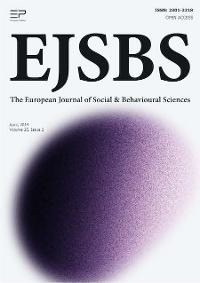Pedagogy and Innovation in Science Education: A Case Study of an Experiential Learning Science Undergraduate Course
Abstract
Experiential learning approaches are desirable in higher education for improving students’ learning experience. However, the effectiveness of implementing such an approach in an undergraduate science course is challenging. How do students develop scientific knowledge and skills through planning and implementing innovative activities for the targeted groups, and how do the implemented activities empirically contribute to theoretical frameworks? This paper discusses the design and implementation of an undergraduate experiential learning course for students from diverse science backgrounds. According to Kolb’s experiential learning approach, this course creates two major experiences for students: conceptual acquisition, and experience of design and implementation of innovative teaching and learning activities. This research investigates a science course aiming to develop student teachers’ ability to design and implement innovative activities in classes. A qualitative research design was adopted to analyse the implementation of experiential learning processes. Owing to the specialty and diversity of the participants involved, an intrinsic case study was conducted to holistically examine the course with a focus on the construction of scientific knowledge and pedagogical issues. Units of analysis involved a series of activities embedded into the course. Specific domains of pedagogical innovation such as Techno-Pedagogy were premeditated. One of the major findings reveals the development of a didactic protocol framing the implementation flow of the experiential learning process associated with emerging innovative teaching components. In short, it shows that the experiential learning approach demonstrates the crucial role of facilitating constructive learning for undergraduate students from various disciplines to develop innovative pedagogical and learning skills.
Keywords: Experiential learning; innovative activity, pedagogy, learning diversity, science education, STEM education
Introduction
Education innovation has received increasing attention over the decades emphasizing the improvements in quality of instruction and curricula (Nathan & Pearson, 2014). A trend of shift in modern education theory has moved away from traditional modes towards a more constructive approach (Smyth et al., 2016). A student-centered learning approach has been developing in education research over the years. In particular, experiential learning promoting learning-by-experiencing has been rapidly expanding in education research (Gorghiu & Ancuta Santi, 2016). Students’ learning is promoted through their active engagement of participating in activities which are structurally designed by educators.
Many universities have adopted the outcome-based teaching and learning approach at the course-wide level, which aims to articulate what educators in higher education expect students to learn with a clear design of effective curriculum, appropriate assessments to measure achievement, and to plan the learning process for the students. However, a gap between student learning activities and intended learning outcomes is commonly found in the design of innovative courses (Biggs & Tang, 2007). One might argue that actual implementation of a university course remains inadequate and more empirical evidence should be sought to support the effectiveness of different pedagogical approaches toward the intended learning outcomes. “Much science education at a tertiary level, even in more innovative courses, still relies on lecture-based teaching and formulaic labs” (Smyth et al., 2016, p.193).
Background
This study was conducted in a university offering mainly theoretical and conceptual science courses for a large number of students. As the majority of the graduates opt to serve as science teachers contributing to the field of education, the importance and necessity of science education training are essentially acknowledged. Teaching experiences as well as professional pedagogical training, therefore, are desired in a way that students could experience activities concerning some major components in education (e.g. design of task, pedagogical skills, psychological issues of students, and so on). Particularly, one distinctive issue for science education is the uniqueness of conducting experiments in the laboratory which necessitates consideration of issues of safety issues. This feature of uniqueness may either stimulate or extinguish students’ interest altogether. One crucial factor to stimulate students to engage in science lessons is the design of the task. The course in this study, in particular, serves as the first and only course offering structural educational training in the university. Enrolment in the course is optional for senior year undergraduate students (advanced level) who have a strong interest in science education; in addition, for those who are preparing to be science teachers in middle and high schools.
Theoretical framework
The study is framed by three related theoretical frameworks; experiential learning (Kolb, 1984), distinctive notions of conception of pedagogical innovation (Walder, 2014) and innovative practice model (Nicolaides, 2012). These theories are briefly described as follows.
Experiential learning
Experiential learning was proposed in 1984 by David Kolb who was influenced by works of John Dewey advocating a fundamental concept of learning by doing (Miettinen, 2000). Kolb (1984) suggests experiential learning as a holistic integrative perspective on learning that “combines experience, perception, cognition and behavior” (p.21), which has been increasingly considered in education research. This type of learning concerns practical aspects of experience actively undertaken by students for the purpose of developing the skills of critical and innovative thinking, reflection, initiative, motivation, curiosity and so on. Metacognitive skills are significantly focused on the process of designing experiential learning activities which emphasize learning by doing (Kolb, 1984) through action, exploration, discovery and active participation (Gorghiu & Ancuta Santi, 2016).
“Learning is a process whereby knowledge is created through the transformation of experience.” (Kolb, 1984, p.38). Kolb (1984) believes experiential learning relies on practical aspects considering that the key to educational success is action taken by individual learners to positively transform their educational experiences. By taking action, exploring situations and discovering things, learners actively engage in learning environments which in turn enhances metacognitive skills. Additionally, collective work based on individualised actions is developed in the process. The learning process is further re-treaded in another situation which forms a complex learning network achieving increasingly higher levels of knowledge construction. Kolb (1984) consolidates the theory into a four-stage cyclic model comprising concrete experience, reflective observation, abstract conceptualisation and active experimentation as shown in Figure 1.
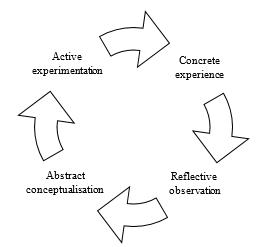
Distinctive notions of conception of pedagogical innovation
Although the innovative teaching and learning method is not a universal remedy (Nicolaides, 2012) and even if there is no absolute definition, educational researchers have attempted to demystify some concepts of innovativeness by exploring some courses that are frontend implemented. Oyelekan Igbokwe, and Olorundare (2017) defines the concept of innovative teaching as a derivation of constructivist learning theory which includes a form of guided discovery in which instructors avoid giving direct instruction but attempt to lead students “to discover, discuss, appreciate and verbalise new knowledge” (p. 52) through questions and activities. Walder (2014) defines the concept of pedagogical innovation in a qualitative way collecting ideas from expertise in higher education. Seven distinct notions of the concept of pedagogical innovation (selected notions are shown in Table 1) are discerned and identified to construct an updated definition.
The notion of novelty represents questioning a new way of teaching which is to “surprise” students. However, in applying the notion of novelty, innovative teachers will have to “surprise” students out of their usual expectations of the learning process. The second notion of change includes slight yet radical interference resulting in new adaptations made by students that teaching and learning mode in lectures should be changed. For example, lectures are switched from traditional face-to-face lectures to blended learning mode (i.e., combination of online and meetings in small groups of students). The third notion of reflection occurs when instructors creatively use the reflections to create new pedagogical formats based on the reflections. The fourth notion of application refers to discourses that correspond to scaffolding what students learn. The fifth notion of improvement describes ways of seeking areas for improvement. For example, inviting colleagues to visit classes allows for interdisciplinary professional exchange improving the quality of teaching. The sixth notion of technology versus pedagogy highlights issues between pedagogical innovation and technological innovation where the proper use of technology may irritate some users (i.e., instructors or students) to mediate content knowledge in the manipulation process with the technological tools. Concrete features of technology can provoke the users to discern certain ideas during the contact process. The last notion of human relations covers various personal aspects that should be considered in terms of individual tolerance towards innovativeness. Referring to the previous notions, instructors should scaffold contents allowing students to achieve reachable levels of concepts in the learning experience.
There are two levels of implications that need to be considered in applying these distinctive notions of conception of pedagogical innovation in this research. One is at the level of the course designers (i.e., the instructors as well) in how the design of the undergraduate course is relevant to the notions of concepts. The other level is at the undergraduate student teachers level in how who will be teaching secondary school students and how they will teach the secondary school students in innovative ways.
Innovative practice model
Nicolaides (2012) believes learning is a social process in terms of the social constructivist paradigm that is not limited to an individual. Meaningful learning experiences take place once individuals are engaged in social activities. Collaboration and communication are essential to the construction of knowledge. Nicolaides (2012) points out, however, that the conventional method of teaching and learning generally adopted is lecturing, whereas communication between two or more persons is influenced in a complex, exciting, challenging and interactive way. Therefore, in innovative lecturing the pedagogical focus of lecturing is shifted from ‘talk and chalk’ to student-centered stimulating students’ learning in order to provoke high-order thinking.
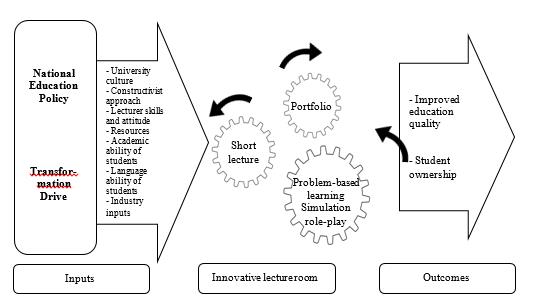
Nicolaides (2012) proposes an innovative practice model consisting of three stages chronologically framing critical considerations in terms of rationale of design of courses, practical implementation of lectures and intended learning outcomes of students. In the first stage, of the model refers to the achievement of fundamental necessity of education, which is easily perceived as the education policy. Objectives of courses accommodate important content for students to learn. It binds the main focus of courses and outlines its design such that critical issues are holistically considered (e.g., culture, teaching and learning approaches, attitudes of students as well as the instructors/designers, external inputs, and etc.). Putting all those issues into consideration, implementation of innovative lecturing is highlighted.
Three elements are proposed in the model, namely short lectures, problem-based learning and simulation role-playing, and learning portfolios. Innovative short lecture method advocates interactive lecturing environment encouraging students to get involved in active debate and discussion on a problem solving case study. Students become active team-players who utilise their prior knowledge and critical thinking techniques to collaboratively construct knowledge.
Problem-based learning and simulation role-playing create a workplace scenario allowing students to encounter and apply their learning in real life situations. It not only allows students to develop social skills, but also collaboratively construct content knowledge through the process of solving the problem which is structurally designed. Learning portfolios play an important role in formative assessment and provide room for students to reflect on their own learning experiences by receiving feedback from instructors. The portfolio intensively makes learning visible (Nicolaides, 2012) where students collect and assimilate critical elements to report in the portfolio demonstrating the effect of these strategies in positively impacting the learning process and experiences.
Ultimate outcomes of the innovative practice model (see Figure 2) advocate an enhancement of education yielding development of students’ creative and intellectual abilities. In addition, students gain ownership of courses is gained and in the process, the ownership of the course is devolved from instructors to the students.
Purpose of the Study
In this paper, a study of an experiential learning science course, offering various opportunities for science students from three different majors (chemistry, mathematics and physics) to create innovative teaching tools to carry out three kinds of tasks (presentations, demonstrations and group activities), is presented. The design of the course follows the general guideline of outcome-based learning approach, aiming to nurture science students’ innovation in creating teaching tools and developing their pedagogical skills with certain concrete experiences throughout the course. The created teaching tools associated with the teaching skills developed in the experiences, thus, are prominently captured and analysed in the study.
Research Questions
To address the research aim of this study, two research questions were raised as follows:
- Was the twofold experiential learning model successful in the implementation of innovative activities for the targeted groups?
- What obstacles were encountered in the in the implementation of innovative activities for the targeted groups using this twofold experiential learning model?
With these two research questions, this research investigates the design and implementation of the course utilising the theories mentioned in previous paragraphs as analytical tools.
Research Method
This study was based on a qualitative research design which investigated an undergraduate experiential learning course in the setting of a single intrinsic case study approach (Yin, 2012) allowing for in-depth, multi-faceted explorations of a bounded situation in real-life settings (Stake, 2010). This intrinsic case study was undertaken to understand a unique phenomenon where the course being studied was specially designed as an experiential learning course promoting teaching and learning science in innovative ways. In particular, instructors from various departments in the School of Science (i.e., Chemistry, Mathematics and Physics) collaborated in designing the course and teaching the corresponding students from the departments. The enrolled students voluntarily applied for the course. Their passion in science teaching was a crucial criterion for admission consideration.
To address the research questions, theories in conducting evaluations (Yin, 2012) played an important role. Pre-course discussions with instructors were conducted to gather instructors’ rationale regarding course design. Instructors-students meetings were conducted while some key activities on teaching were videotaped for further analysis. A semi-structured focus group interview, about the issues of pragmatic implementation of the activities, was conducted at the end of the course in order to gather viewpoints of students toward the course. Documentation, including portfolio analysis, was employed to systematically analyse the case to generate meaningful insights and to serve as triangulation.
The videotaped lectures and the portfolios served to critically analyse the innovative ideas embedded in the design of the activities. Feedback from the instructors and students was collected at both the pre- and post-course interviews so as to triangulate the students’ ideas about pedagogical innovation and the practical innovative models as addressed in theoretical frameworks. Figure 3 shows the flow chart of this data analysis process.

Results
The innovative practice model frames a pragmatic course of teaching and learning enhancing innovativeness of content in three stages i.e., input, lecturing and outcomes. This study focused on investigating practical lecturing formats which conceive of teaching and learning as interactions among instructors and undergraduate students. To holistically analyse the situation, triangulation of input and outcomes of the course (i.e., design of the course and the students’ work generating from the course) was considered.
Problem-based learning
Throughout the course, the students were asked to create and implement three innovative teaching activities. Similar to teaching practices offered in training for pre-service teachers, this workplace scenario allowed the students to develop the innovativeness of the prepared materials in the teaching activities. The “role-playing” element in the course promoted an evaluation and synthesis of teaching while the students could learn how to teach innovatively by “doing something” which reflected authentic teaching practices. In this scenario, the students were not only being practitioners who prepared and implemented teaching in innovative ways, but also student-teachers who reflected on the prepared innovative teaching materials allowing the students to justify teaching effectiveness in practice.
Some students revealed in their reflective portfolios that being teachers is not an easy task. After taking the course, they reflected that becoming equipped with effective and innovative teaching skills has to be gained from experience. Apart from receiving direct pedagogical skills from instructors in lectures, this kind of reflection from the students conveys importance of “learning by doing” in the learning experience. It also aligned with the problem-based learning approach focusing on process of solving problems as well its implications (Benjamin & Keenan, 2006).
In addition to the creation of innovative activities, students actively took greater responsibility for their learning as they had to examine proper topics to be taught, create innovative teaching tools, verify validation of the selected topics and way of teaching, implement the design, and review the implementation. This process of learning can be viewed as a protocol of solving a problem which is defined as creation of innovative learning experience in science for students from secondary schools.
Short lectures
In short lectures, the role of lecturers (also known as instructors) is viewed as facilitators to guide and promote student interaction (Nicolaides, 2012). Instructors did not directly deliver pedagogical theories to the students in the lectures. Instead, they offered short lectures and meeting sessions with individual groups of students, which fostered students’ understanding of these pedagogical theories (see fig. 4-5). Instructors, in some short lectures, introduced some showcases of trendy innovative teaching tools to the students, for example, engaging students to explore a scientific concept through watching a popular movie. The selection of movies, extraction of scientific knowledge from it and didactical considerations of engaging students to actively learn the knowledge, were demonstrated by the instructors facilitating the students to reinvent innovativeness of teaching and learning science in the short lectures. Student involvement in the short lectures was prominent that they acted as team-players (as they co-taught in the designated activities) and role-players (as they acted as teachers in the activities). Hence, the ownership of the course was switched from instructors to the students who understood that the designated activities would be organised by themselves.
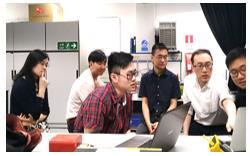
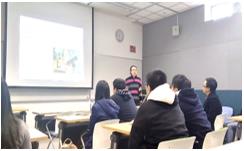
Portfolio
Portfolio as one of the assessment methods is widely being used for assessing not only students’ knowledge and skills, but also acquisition process of the knowledge and the skills. In addition, individual differences, occupational values, and problem solving skills could be reflected in a well-designed portfolio (Parlakyildiz, 2015). Assessing students’ abilities through portfolio is different from requiring students to take examination, as the portfolio allows students to holistically collect and reflect on relevant ideas and concepts learnt from the experience. In this study, the portfolio was designed in two parts. The first part of the portfolio required students to reflect mainly on the experiences they had engaged in which they had to submit to the instructor during the middle stage of the course. The second part of the portfolio including reflection of the whole learning process, was submitted by the end of the course as a formative assessment. Submission of the first part of it served the aim of progressively investigating students’ learning so that the instructors could review and provide instant feedback to the students. The instructors scaffolded students’ learning directions and consolidated students’ conceptual development. The guidance given by the instructors commenting on the first part of the portfolio, in addition, provoked the students to explicitly frame the design of innovative activities. Furthermore, first submission of the first part of the portfolio served as a record, similar to the purpose of using logbook, allowing the students to review their own ideas and trace the learning trajectory in the experiential learning process.
Innovative teaching and learning
Pedagogical innovation yields an intentional action aiming to introduce an original context in ways of seeking substantial improvement of students’ learning through interactivity and engagement (cited in Walder, 2014). Various distinctive notions of conception of pedagogical innovation, captured in the section of theoretical frameworks, were demonstrated in the analysis of the implementation of innovative activities designed by the students.
Novelty
The students, who were the designers of innovative teaching activities, endeavored to create something for the first time which moved away from tradition. Surprising the audience (the students from secondary schools) with the unanticipated effects of embedding scientific knowledge was one consideration in the introductory of the activities. Figure 6a shows an experimental setup to demonstrate acoustic levitation of small plastic foam balls by utilizing the properties of standing waves produced by arrays of speakers. Figure 6b shows the circuitry of a home-brewed electric guitar. Mechanical oscillations of a plucked guitar string are transformed into electrical signals by the principle of electromagnetic induction. The feeble signals are then amplified by an electronic circuit.
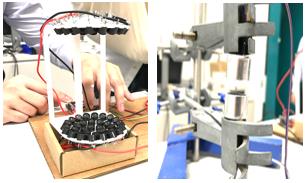
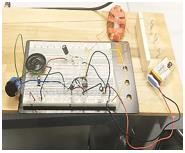
Change
In the series of three innovative activities designed by students, named lectures, demonstrations and group activities, the students changed the mode of teaching science from lecturing to interactive implication. One example showed in Figure 7a and 7b illustrating a group of Chemistry students creating a crime scene scenario. The scenario allowed the participants (the students from secondary schools) to role-play as inspectors to conduct different types of experiments, for example, detection of blood, fingerprint and hidden message, to acquire certain scientific knowledge (e.g., polymerization, catalysis and pH indicators). The inspector role-play activity had twofold implications that fostered both undergraduate and secondary level students to carry out experiential learning. On one hand, from the undergraduate students’ perspective, they designed the innovative role-play activity changing the didactic mode of teaching to student-centered active learning. In addition, the role of teachers in the activity was changed to facilitators and inspector assistants who answered the questions raised by the participants and guided them to conduct the experiments. On the other hand, from the secondary school students’ perspective, active learning was advocated that the participating students took ownership of the activity requiring them to take certain actions to explore and acquire the knowledge to be taught.
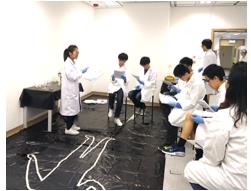
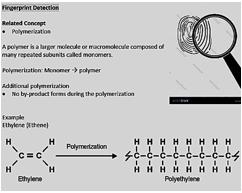
Techno-Pedagogy
Interactive technological tools were commonly used by the undergraduate students who were eager to encourage secondary school students to participate in the activities. For example, a student majoring in mathematics designed an activity introducing decibel level of sounds embedding the concept of logarithm. The student utilised an application installed in a tablet detecting decibel levels of different sounds in the classroom. With the interactive activities created by the student, participants were asked to install the application in their own smartphones and manipulated it to accomplish certain tasks. The technology allowed the students to visualise the “amplitude” of sound wave on the screen. The visualisation experience stimulated the students (the participants) to explore on their own where they could generate different kinds of voice associated with the corresponding decibel levels of sounds (see figure 8). With the fundamental experience of visualising the sounds, the student teacher further discussed mathematical concepts behind the decibel levels of sound relating to the idea of logarithm.
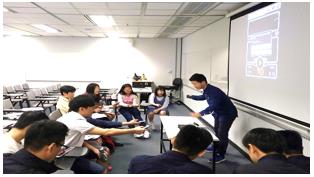
Reflection & improvement
This section combined discussion on notions of reflection and improvement as these two important components were intertwined in the case. Walder (2014) emphasizes the pedagogical reflection in the notion of reflection, which could be deeply implicated in the analysis of portfolios done by the students. The development of didactic knowledge had been processed from the workshop offered by educators at the beginning of the course to implementation of the designed activities performed by the students themselves. This deductive approach of pedagogy development was adopted since the students had no prior knowledge of educational training. The ideas developed from the workshop served as a fundamental background. Therefore, the content covered in the workshop should be precisely designed such that the students, on one hand, could gain certain basic ideas on teaching and learning, while on the other hand, it would not restrict the creativity of the students to create innovative teaching tools.
The students were asked to reflect according to guided questions in the portfolio. The reflection pages provoked the students to objectively write down the key elements emerged in particular sessions in the course, at the same time, to analyse what they should do to further improve the based on the reflective key elements gathered. In particular, the instructors as designers of the portfolio, split the portfolio into two parts provoking critical concerns of reflection and improvement for the students. The first part of the portfolio allowed the students to gather meaningful information in their experience, which was framed by Kolb’s cycle of experiential learning.
Application
The idea that “pedagogical innovation is construction” (Walder, 2014, p.199) is prominent in the literature illustrating instructors’ discourses and corresponds to the students’ (also known as participants’) feedback. Walder (2014) uses an example of the notion of application that instructors use student response systems (e.g., clickers) to obtain instant feedback in order to assess students’ understanding. Familiarization in using technology is essential and instructors should teach the students how to use it in practice. Instructors should scaffold the students in construction of knowledge as well as practical manipulation of technology (Lei & Leung, 2017). In the course, the undergraduate students, as student-teachers, introduced some innovative teaching tools using technology. Due to the limited time assigned in the activities, the participants (i.e., the students from secondary schools) had insufficient time to become familiar with the tools. The student-teachers revealed that they focused on teaching the participants to use the tools to acquire certain scientific knowledge. This approach limited the participants to freely manipulate the tools in order to explore ways to accomplish tasks.
Human relations
Pedagogy could not be innovated solely by instructors, undergraduate students or secondary school students. Effective and innovative teaching should be advocated by stakeholders of the course. A course cannot be innovative if no student engages with the lesson. In this study, an undergraduate student revealed in the post-course interview that innovative lessons could consist of two major components which were innovative tools and innovative teaching methods. The emergence of these two components should be mutually considered. First, a teaching tool should be innovative in the sense that designers should consider its new features (especially for technological tools) such that students could manipulate it in order to acquire certain knowledge Second, teaching methods (e.g., playing games or trial-and-error experimentation) should be innovative in the sense that the innovative teaching tools (or other tools) are utilised to stimulate creativity so that knowledge could be attained and strengthened effectively. Thus, the human relationship is activated between teachers and students via the innovative pedagogy orchestrated by the teachers to guide students to work with the innovative tools.
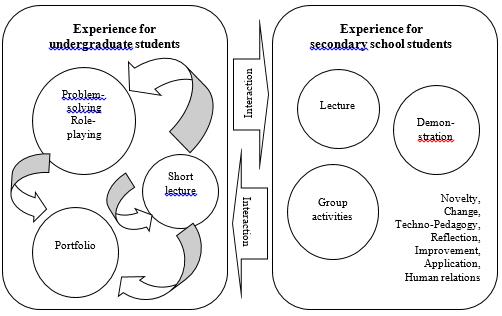
In this study, the student teachers and students from secondary schools interacted closely at the workshops as observed by the instructors. Learning experiences of both parties were intertwined that the innovative learning activities experienced by the secondary school students were designed by the student teachers. Meanwhile, the student teachers were experiencing a different learning process by learning how to construct science knowledge in effective ways. Figure 9 shows a twofold experiential learning model in two aspects, viz. the student teachers and secondary school students. On one hand, the student teachers experienced critical stages in conceptualising teaching and learning concepts through short lectures and meetings with instructors. The ‘role-play’ teaching activities allowed the students to act as teachers to implement the designated innovative teaching tasks in practices conceiving the ‘hands-on’ experience. The student teachers reflected on their own teaching performance as well as learning outcomes of the secondary school students according to the guided questions in the portfolio. Therefore, the portfolio played an important role in the cognitive reflection of the UG students throughout the experiential learning process. On the other hand, the learning experience of the secondary school students was based on the innovative activities created by the student teachers. The three types of activities (i.e., lecture, demonstration and group activities) provoked the secondary school students to approach science knowledge in critical ways. The notions of pedagogical innovation were demonstrated in the activities collaboratively conducted by the student teachers and secondary school students, enhancing each other’s teaching and learning experiences. These two essential aspects were incorporated into a didactic protocol, establishing holistic experiential learning; and thus the twofold experiential learning model was successful in the implementation of innovative activities for the targeted groups.
Discussion and conclusion
This study investigates a case promoting science education in innovative ways. A few obstacles were reported when the innovative teaching and learning activities were being implemented. Some of these included the difficulty in evaluating the level of innovativeness owing to lack of a concrete generic definition of “innovation”; the difficulty in striking a balance between the UG students’ final formulation of feasible deliverables and their original creative ideas; and the difficulty in establishing and maintaining an effective interaction between the UG students and the secondary school students who were silent and passive. Further investigation could be conducted particularly on examining unsuccessful parts of the designed activities which affected the effectiveness of students’ learning.
The innovative practice model proposed by Nicolaides (2012) yields three stages; categorising input, innovative lecture and outcomes of students. The twofold didactic protocol of the experiential learning model provides significant insights to innovative pedagogy at the secondary level and higher education. This, in advance, constitutes a pragmatic cooperation of student teachers and teachers from secondary schools and the university. Basing on this explorative study on innovative pedagogies in an experiential-learning mode, the instructors seek to investigate the interplay and bridging between the two different levels of science knowledge when the same course is offered in the future.
A harmonious integration of these three core disciplines in science (even including more disciplines) to generate a didactic model in STEM education (Ruthven et al., 2016) is recommended.
Therefore, a further exploration of STEM education is proposed to expand the study in order to theoretically enrich STEM education literature especially in innovative pedagogy.
In conclusion, this research explores an experiential learning course fostering two groups of students (undergraduate student teachers and secondary school students) to create innovative pedagogies and experience innovative activities respectively. The twofold model provides insights for instructors and students in tertiary education to create innovative activities for learning science.
Acknowledgements
The investigated course is funded by Teaching Development Grant, Hong Kong University of Science and Technology.
References
Ambrose, S.A., Bridges, M.W., Di Pietro, M., Lovett, M.C., & Norman, M.K. (2010). How learning works: 7 research-based principles for smarts teaching. San Francisco, CA: Jossey-Bass.
Benjamin, C., & Keenan, C. (2006). Implications of introducing problem-based learning in a traditionally taught course. Engineering education 1, 2-7.
Biggs, J., & Tang, C. (2007). Using constructive alignment in outcomes-based teaching and learning. Teaching for quality learning at university (3rd ed.). (pp. 50-63). Maidenhead: Open University Press.
Gorghiu, G., & Ancuta Santi, E. (2016). Applications of experiential learning in science education non-formal contexts. The European proceedings of social & behavioural sciences, 16, 320-326. DOI:
Kolb, D. (1984). Experiential learning. Manchester: University of Manchester Press.
Lei, H., & Leung, A. (2017). Tool-based mathematics lesson: a case study in transitions of activities in didactical cycle. In B. Kaur, W.K. Ho, T.L. Toh, & B.H. Choy, (Eds.), Proceedings of the 41st Conference of the International Group for the Psychology of Mathematics Education, 3, 145-152. 17-22 July, Singapore: PME.
Miettinen, R. (2000). The concept of experiential learning and John Dewey’s theory of reflective thought and action. International Journal of Lifelong Education, 19(1), 54-72.
Nathan, M., & Pearson, G. (2014). Integration in K-12 STEM education: status, prospects, and an agenda for research. 121st ASEE Conference and Exposition.15-18 June, Indianapolis, Indiana.
Nicolaides, A. (2012). Innovative teaching and learning methodologies for higher education institutions. Educational research, 3(8), 620-626.
Oyelekan, O.S., Igbokwe, E.F., & Olorundare, A. S. (2017). Science Teachers’ Utilization of Innovative Strategies for Teaching Senior School Science in Ilorin, Nigeria, Malaysian Online Journal of Educational Sciences, 5(2), 49-65.
Parlakyildiz, B. (2015). In science and maths education, the portfolio implementations of prospective preschool teachers. American Journal of Educational Research, 3(10), 1243-1252.
Ruthven, K., Mercer, N., Taber, K.S., Guardia, P., Hofmann, R., Ilie, S., Luthman, S., & Riga, F. (2016). A research-informed dialogic-teaching approach to early secondary school mathematics and science: the pedagogical design and field trial of the episteme intervention. Research Papers in Education, 32(1), 18-40.
Smyth, L., Davila, F., Sloan, T., Rykers, E., Backwell, S., & Jones, S.B. (2016). How science really works: the student experience of research-led education. Higher Education, 72(2), 191–207.
Stake, R.E. (2010). Qualitative research: studying how things work. New Work: Guilford Press.
Walder, A. M. (2014). The concept of pedagogical innovation in higher education. Education Journal, 3(3), 195-202.
Yin, R.K. (2012). Applications of case study research (3rd ed.). Thousand Oaks, CA: Sage.
Copyright information

This work is licensed under a Creative Commons Attribution-NonCommercial-NoDerivatives 4.0 International License.


